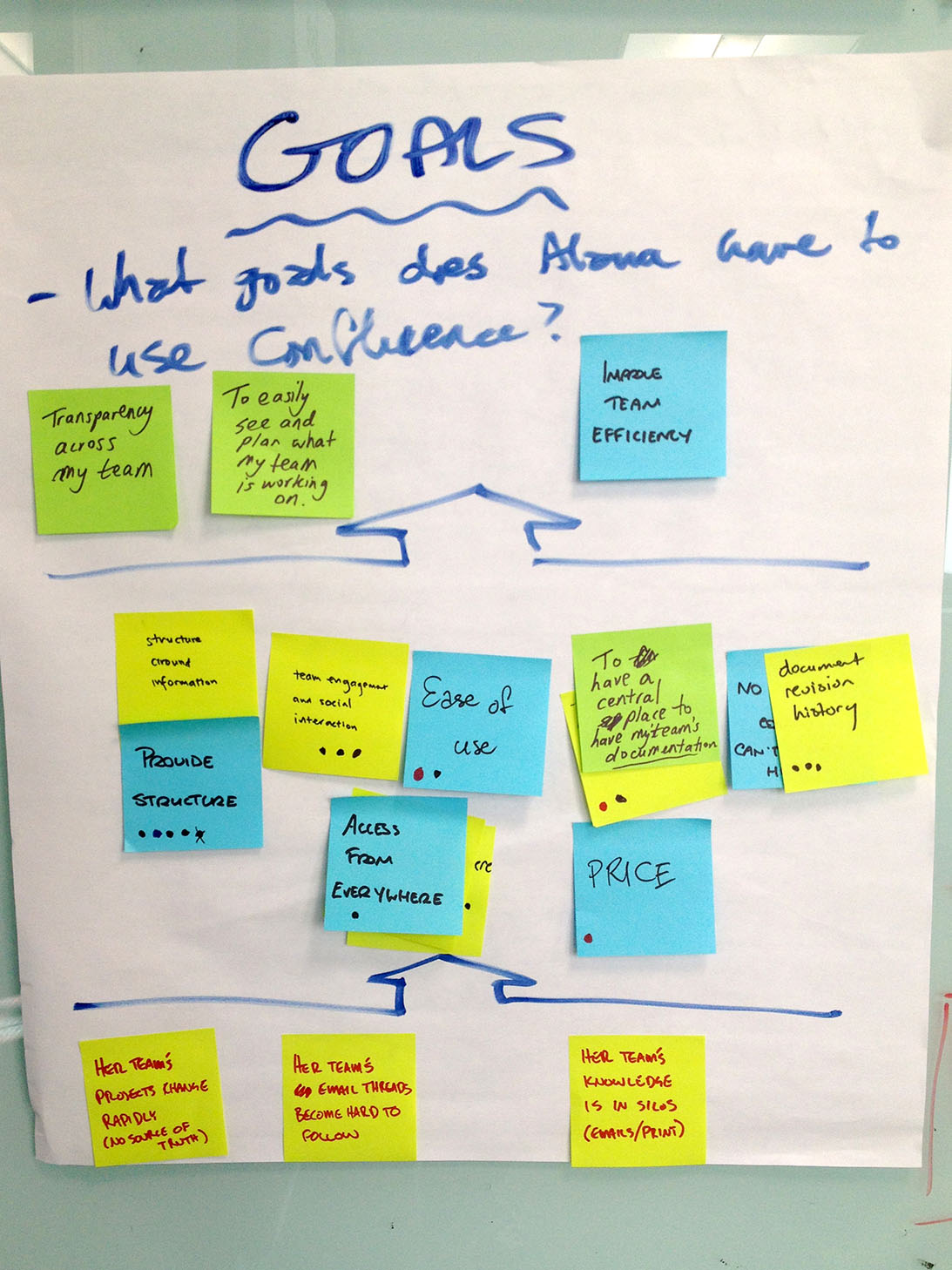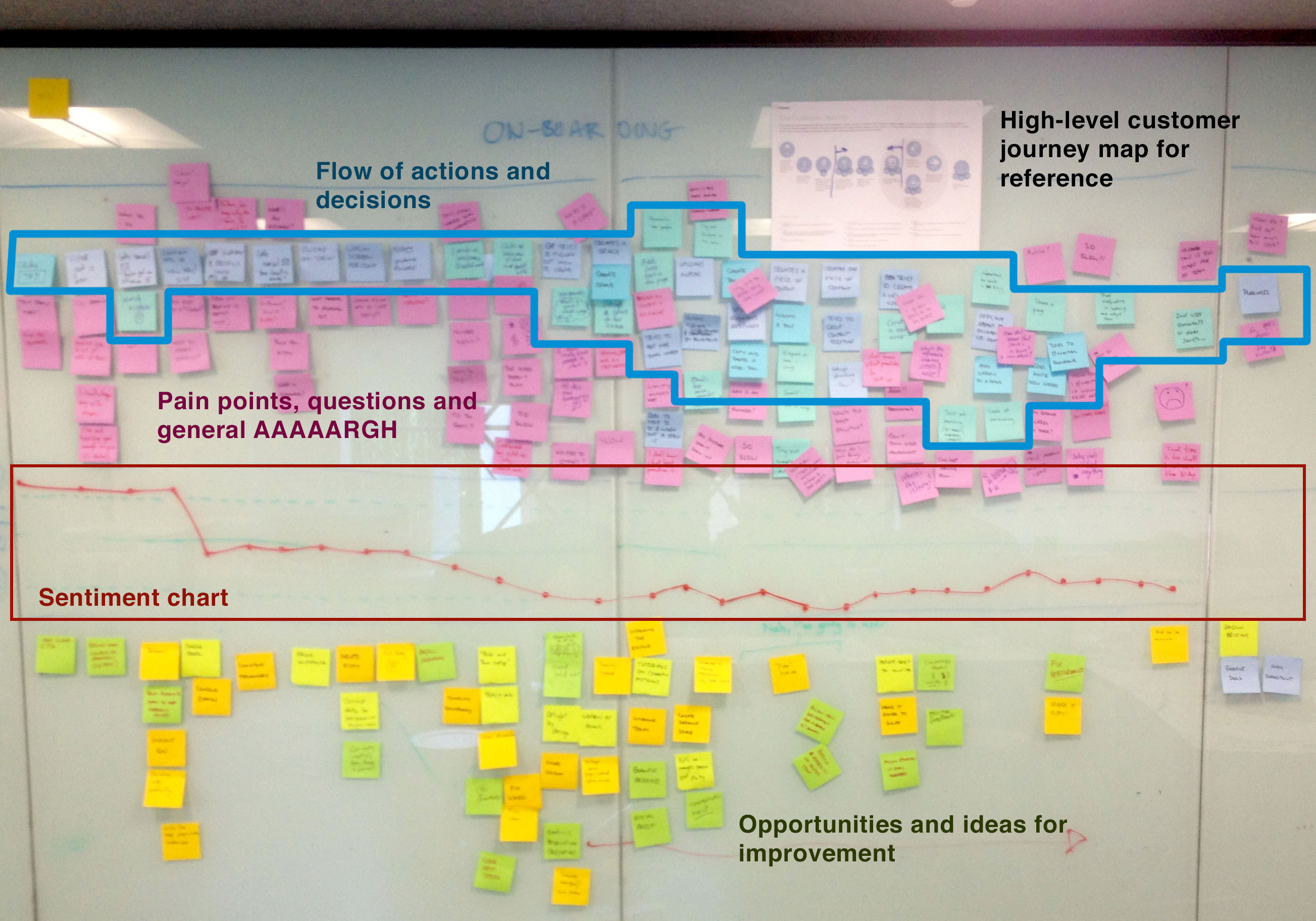
人员
4 - 8

准备时间
15 分钟

时间
90 分钟

难度
困难
使用此技巧
根据您所绘制的客户旅程中的接触点数量,您可以将旅程分为几个阶段,并两人一组来处理每个阶段。
第 1 步
搭建舞台(5 分钟)
让您的小组了解用户角色和驱动客户旅程的目标,这一点非常重要。与小组成员一起决定或概述目标角色以及会议中探讨的旅程范围。确保至少在会议开始前一周与团队预先分享必读内容,以确保每个人都了解角色和旅程范围,并有机会在需要时更深入地研究资料和数据。更好的办法是,邀请团队成员主持或参加客户访谈,亲身聆听客户的意见!
例如,“我们将重点关注 Alana 的角色。Alana 的角色是项目经理,她的目标是找到一种可扩展的方式让她的团队分享知识,这样他们就可以减少通过电子邮件解释事情的时间。我们将绘制出 Alana 为此目的评估 Confluence 的情况,从她单击 TRY(试用)按钮开始,到她决定购买或不购买。”
第 2 步
撰写客户背景故事(10 分钟)
让小组使用便利贴来发布您的目标角色最初会出现在这段旅程中的原因。很可能您会得到各种各样的回复:从高层次的目标到痛点,再到要求的功能或服务,应有尽有。将相似的想法分组并整理便利贴,这样您就可以根据它们设计故事。
这些陈述应该从实际客户访谈中获得启发。同时,每个团队成员也将在会议中带来不同的视角,这有助于拓宽视野。
看看本节标注中提供的示例。这个背景故事从痛点开始,也就是 Alana 一开始想要像 Confluence 这样的软件的原因。
- 例如,“她的团队的知识处于孤岛状态”
然后基本上会有一份需求清单,即 Alana 在产品中寻找什么来解决最底层的痛点。这本质上是一份心理购物清单,供小组在绘制客户旅程时参考。
- 例如,“提供结构”
然后是结果——Alana 想要通过使用产品实现的目标
- 例如,“让我的团队专注于工作,而不是被不必要的电子邮件和闲聊分散注意力”
最后是她和她的团队的最高层次目标。
- 例如,“提高团队效率”
让某人大声说出他们认为到目前为止的总体情况,突出客户的主要目标,从而为背景故事画上圆满的句号。这样可以确保达成共识,为旅程地图提供信息,并提高您的团队从角色角度(而不是自己的角度)绘制旅程地图的机会。
- 例如,“Alana 和她的团队需要花费大量时间向彼此和利益相关者解释他们的工作,这让他们感到沮丧。他们想要一种分享知识和整理知识的方法,以便团队外的人就可以轻松找到这些知识,这样他们就可以将更多精力集中在手头的任务上。”

例如...
以下是 Confluence 团队创建的背景故事。
第 3 步
绘制客户的想法和感受(30-60 分钟)
目标角色、背景故事和目的地都已准备就绪,是时候代入客户的角色了。在便利贴上写下角色做的第一件事,向参与者展示如何开始行动。然后,整个小组可以拿起便利贴和标记笔,继续逐个操作绘制旅程,一次绘制一个操作。
这也可以包括问题和决定!如果旅程根据答案或选择创建分支,则让一名参与者绘制每条路径。请注意,这个技巧的目的是帮助团队建立对客户的共鸣和共识。为此,我们专注于绘制离散端到端旅程的当前状态,并寻找改进的机会。
为了进行更全面的探索并为制定策略提供参考信息,您需要更深入地研究和设计这些旅程地图,这需要分成多个阶段来完成。请查看以下变体,了解如何设计全新的客户旅程。
专业提示
在操作、问题、决策等方面使用不同颜色的便利贴,这样当您查看整张地图时,更容易看到每个元素。
对于客户旅程中的每个操作,记录进行互动所用的渠道。根据您的情况,渠道可能包括网站、电话、电子邮件、邮寄邮件、面对面和/或社交媒体。
在视觉上将绘制区域划分为多个区域,例如在“前台”(客户体验什么)和“后台”(哪些系统和流程在后台处于活动状态)。
旅程地图可以引发丰富的讨论,但要尽量避免深入研究错误的细节。我们的想法是探索这段旅程并挖掘出来,寻找改善体验的机会,而不是当场想出解决方案。不仅要保持对话正常进行,还要创建一个未来容易参考的文档,这非常重要。在 Confluence 模板中使用扩展或脚注来捕获任何额外的背景信息,同时保持文档概述稳定。
试着成为评论员,而不是批评家。请记住:您在那里是为了了解角色发生了什么,而不是解释内部系统和流程发生了什么。
要更详细地了解提供“前台”客户价值所需的“后台”流程,可以考虑随后使用 Confluence 白板的服务蓝图模板来跟进这个技巧。

反模式
您的地图上有大量的分支和循环。
您的范围可能太广泛。绘制以特定任务为重点的特定旅程,而不是绘制客户首次探索的方式。
第 4 步
绘制痛点(10-30 分钟)
“好吧,让我看看哪里有困难。”回到地图上,在便利贴上记下痛点。将它们放在旅程中相应的接触点下方。哪里有挫败感?错误?瓶颈?事情没有按预期进行?
为了获得附加价值,谈谈每个痛点的影响。影响是微不足道的,还是可能需要某种解决方案或变通方法。更糟糕的是:这是否会导致角色完全放弃旅程?
第 5 步
绘制情绪线(15 分钟)
(可选,但完全值得。)在旅程地图下方的某个区域绘制角色的情绪,这样您就可以看到他们的情感体验如何随着每个接触点的变化而变化。寻找类似下方的东西:
- 波动情绪的领域——上下波动很常见,但这并不意味着角色不会感觉筋疲力尽。
- 快速下降——这表明期望和挫折感差距很大。
- 低谷——这表明有机会提升整体情绪。
- 正峰 - 您能设计出一种让他们更上一层楼的体验吗?您能取悦这个角色并激励此人推荐您吗?
请记住,痛点并不总是会导致客户情绪立即下降。有时候,一些摩擦甚至可能建立信任(例如,要求进行验证)。另外,随着不断积累,旅程早期的痛点以后可能会导致负面情绪。
专业提示
让客户参与会话来帮助验证旅程地图并提出异议,这意味着您对本次会话的结果更有信心。
第 6 步
分析大局(15 分钟)
作为一个小组,退出旅程地图,讨论体验中的趋势和模式。
- 最令人困惑/沮丧的方面是哪里?
- 这段旅程哪方面没有达到预期?
- 该用户类型是否出现了任何新的未满足的需求?
- 流程中是否存在不必要的复杂或重复的区域?是否发送了很多实际上没用的电子邮件?
然后,讨论改善体验的机会领域。例如,在流程中是否有可以将七个步骤减少为三个步骤的领域?那封验证电子邮件真的需要吗?
您可以使用定量数据来验证所确定的各种机会领域的影响。某个步骤可能确实是客户体验中的短板,但实际受到该步骤影响的客户有多少?作为一个团队,专注于另一个影响更大的机会是否会更好?

例如...
这是我们 Engaging First Impressions 团队创建的用户入职旅程地图。
搞定了?
请务必与您的团队共同运行一次完整的状况监控会话或检查点,从而验证是否有所改善。
变体
绘制未来状态
无需绘制当前体验,而是绘出您尚未提供的体验。您可以绘制一个只是改善现有痛点的地图,也可以设计一个极富远见的超棒体验!
只要确保您的想法始终建立在真实的客户访谈和数据基础之上即可。在设计全新的客户旅程时,绘制竞争对手或同行客户旅程以寻找灵感也可能很有趣。致力于提供个性化服务?他们在杂货店里是如何做的?时尚领域呢?金融领域呢?
跟进
绘制旅程地图会话结束后,应当创建利益相关者摘要。哪些痛点对客户对我们产品的评估、采用和使用影响最大?有哪些机会?哪些团队应该知道这些机会?解决这些痛点的行动计划是怎样的?以摘要形式呈现这些信息,以便快速分享关键要点。
为了满足更广泛受众的需求,或者让利益相关者能够更深入地了解,您还可以根据您的分析和所提出的建议、记录的笔记、群组照片以及在 Confluence 页面上创建的工件来撰写详细报告。以旅程地图漫游的形式将这些信息在视频中呈现出来,是分享这些信息的好方法。而 Loom 是一款绝佳的视频制作工具,观看者可以对旅程的特定阶段进行评论。这种方式可以很好地激励组织进行变革,并为以客户为中心的设计实践提供了一种模式。
保持真实
您已经采访了客户,并制作了客户旅程地图,现在就返回到客户进行验证吧!是的:您可能会发现自己的整张地图都是无效的,必须从头开始。(现在发现总比提交旅程地图之后才发现要好!)主要计划通常会制作多张旅程地图来捕捉多个角色的需求,并且经常在每张地图上进行迭代。千万不要觉得这样就一劳永逸了。旅程很快就会中断,只有随时关注客户的现实状况,团队才能根据需要随时进行调整并获得成果!
想要更多手册?
请将您的电子邮件发送到下方,以便在我们添加新的状况监控和剧本时收到通知。
得到反馈吗?
在 Atlassian 社区网站上提问或发表评论。


